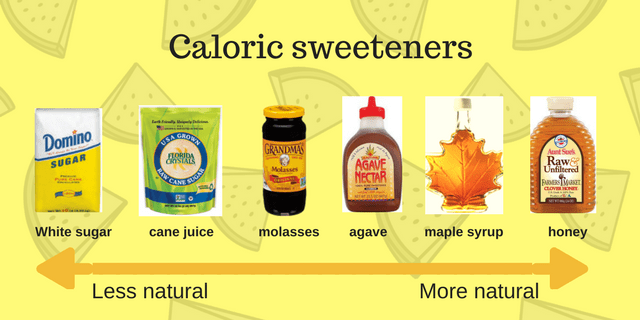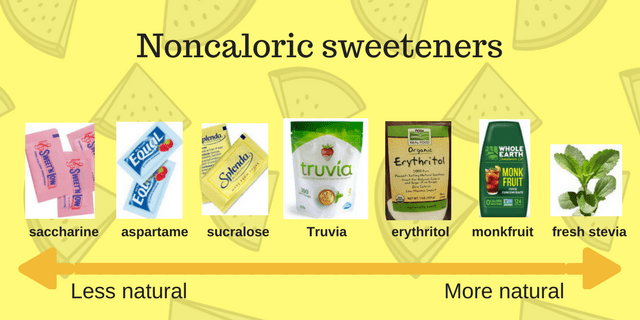Cathy writes:
“Regarding the recent Nutrition Diva episode about artificial sweeteners, how exactly do you define “artificial” when it comes to sweeteners?”
Cathy is absolutely right that the terminology used to talk about sweeteners is vague and I should be better about defining my terms!
Caloric vs. noncaloric
Sweeteners can be divided into two broad categories: caloric and non-caloric. Even there, it gets fuzzy because virtually all “non-caloric” sweeteners are not truly zero-calorie, just so low in calories that we consider them non-caloric.
I think it’s smart to limit your consumption of both caloric and non-caloric sweeteners to around 5% of calories (or the equivalent amount of noncaloric options).
See also: What’s a safe intake of noncaloric sweetener?
How natural is it?
Although we often use words like natural, processed, refined, synthetic, and artificial to describe various caloric and non-caloric sweeteners, these are not precisely defined terms or categories.
Perhaps it’s more useful to think of sweeteners (whether caloric or non-caloric) as existing on a spectrum, from the least natural to the most natural. For caloric sweeteners, the spectrum might look something like this:

For non-caloric sweeteners, the spectrum might look something like this:

Does it matter whether your sweetener is natural?
If you keep your consumption of caloric sweeteners to 5-10% of calories, I don’t think it really matters where on the spectrum you choose. For the non-caloric sweeteners, I think it’s wise to limit consumption AND stick to the right end of the spectrum.

These charts are great, but this may still add to the confusion with stevia. The vast majority are NOT using “fresh” stevia, rather the laboratory version in which the sweetest components are extracted and dried into crystals. Where exactly does this fall onto the spectrum?
Yes, you’re right! Including the fresh stevia in my chart was a way to make exactly that point! I’d put refined stevia in the same part of the spectrum as Truvia (which is refined stevia extract plus erythritol).
Ah but don’t some of the artificial sweeteners actually cause increases in your blood glucose? Important in selection?
Not directly. But they may affect glucose response to other foods via their effect on gut bacteria. That’s one of the reasons that I recommend limiting the amount of non caloric sweeteners as well as sticking to the right end of the spectrum. So far, the sweeteners that have raised this concern are Splenda, saccharine, and equal but not sugar alcohols or stevia based sweeteners.
Awesome thanks!
What are your feelings on low carb diet and Keto diet?
Here are some articles I’ve written on these topics:
https://www.quickanddirtytips.com/health-fitness/healthy-eating/do-low-carb-diets-work
https://www.quickanddirtytips.com/health-fitness/healthy-eating/which-diet-works-best
https://www.quickanddirtytips.com/health-fitness/trends-fads/carbs-or-fat-which-is-the-bodys-preferred-fuel-source
https://www.quickanddirtytips.com/health-fitness/weight-loss/is-low-fat-or-low-carb-better-for-weight-loss